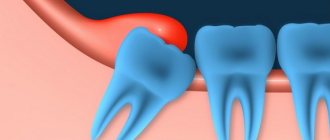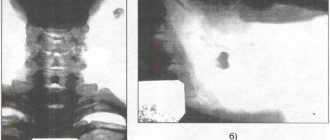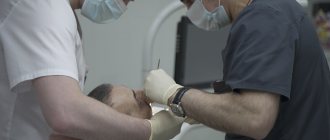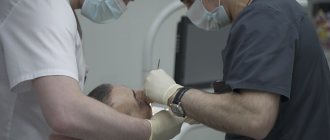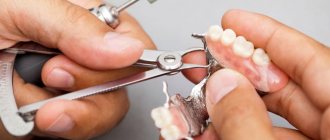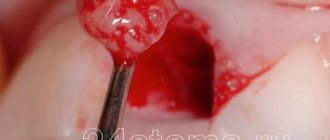All about why dental replantation is needed and which patients are suitable for this procedure
Imagine this situation: you lost a healthy tooth as a result of a fall or jaw injury. Yes, it's unpleasant. I want to run to the dentist to get prosthetics or implantation done. It’s really worth rushing to see a doctor, but perhaps your problem can be helped in a less radical way. In this situation, the doctor may suggest a procedure such as tooth replantation. What kind of technology is this, in what cases is it used and what are its features? Details in today's article.
Replacing an artificial root
Sometimes it happens that the patient’s body rejects the implant. Most often this happens due to the fact that the body perceives the implant material as a foreign body. In this case, the dentist has no choice but to remove the implant. Fortunately, nowadays it is possible to reuse an implant of a different design. Reimplantation is necessary in the following cases:
- implant rejection;
- dentist mistakes;
- use of a defective implant;
- the patient’s failure to comply with the dentist’s recommendations;
- deterioration of general health;
- expired implant.
Separately, it is worth mentioning jaw injuries. Sometimes even a minor injury causes the artificial structure to begin to wobble. In this case, you have to resort to reimplantation.
At the same time, a worn-out crown can be replaced by installing it on the previous artificial root. The same applies to replacing the abutment - the connecting link between the crown and the implant.
Features of the method
Today in dentistry there is a unique technique - tooth replantation surgery, thanks to which you can implant a fallen, extracted or dislocated tooth back into its alveolar bed.
Can all units be returned this way? No, most often the procedure is performed on the front teeth, which have one root - the incisors and canines. If these are molars and premolars, which have many roots (and they are branched), then manipulations upon returning to the alveolus are carried out much less frequently, and it is much more difficult to guarantee a positive outcome.
The success of the operation largely depends on the speed at which the tooth returns to its place after falling out. In an ideal situation, it is better to do this on the same day, but some researchers give an even shorter time frame - within an hour from the moment of loss.
Which tooth can be reimplanted?
A lost tooth can be implanted only if it meets certain conditions. These are:
- integrity of the tooth crown;
- straight tooth roots;
- proper storage of a lost tooth (up to two days in a sodium chloride solution at a temperature of 37 - 40 degrees).
The success of this operation greatly depends on the professionalism of the dentist. This is especially true when the tooth is not lost, but is severely loosened due to injury. Such a tooth sometimes has to be carefully removed and then put back in place.
About indications and contraindications for the procedure
Replantation is an operation for which there are serious indications and contraindications. We consider the main ones in the table below.
| Indications | Contraindications |
|
|
Replantation is not performed in cases where the crown is covered with cracks, is severely damaged and cannot be restored. The procedure is not advisable if, after examination, the doctor reveals serious damage to the socket, gums and bone tissue in the area of the lost unit.
Another serious contraindication is the absence of teeth on the sides of the one that needs to be replanted, because after the operation he will literally need support from the “neighbors”; the entire load will fall on them until the periodontal ligaments and tissues are restored and will get stronger.
Reimplantation of a natural tooth with splinting
In some cases, the installed tooth must be strengthened. This technique is called splinting. Its essence is to install a special thin plate or aramid thread on the inner surface of the tooth crown and on two adjacent teeth. In addition, splinting can be done using caps. In the latter case, the patient will have to wear them for a month, or even a month and a half.
Splinting in most cases is used for dislocated teeth, as well as single-rooted ones. Multi-rooted teeth are installed without splinting. The splinted tooth is excluded from the bite by slightly grinding down the tubercles on its upper part.
Types of replantation and their features
There are two types of surgery: vital replantation and devital replantation.
Vital method
It is understood that the doctor returns the tooth to its place with a living and healthy pulp. As a rule, the indication for the procedure is a dislocation due to injury resulting from accidents, fights, falls, or excessive mechanical pressure on the jaw.
From a technical point of view, the procedure does not present any difficulties and does not require serious preparation, and the tooth itself does not undergo filling or other manipulations before being implanted into the alveolus; it only undergoes antiseptic treatment and is cleared of scraps of gum and periodontal tissue (if it has been dislocated).
Important! The patient needs to see a doctor as soon as possible if a situation arises that provokes tooth loss - the success of the operation directly depends on this.
Replantation of a dislocated or knocked out tooth has a favorable prognosis; after tissue healing, it can function successfully for at least ten years.
Devital technique
The tooth that is returned to the socket is first depulped, that is, the nerve is removed from it. The indication for devital treatment technique is often chronic periodontitis.
The peculiarity of this technique is that first the doctor carries out the removal procedure, then cleans the hole from granulations, and the tooth itself is carefully treated with antiseptics, after which it cleans and seals the roots. To exclude relapses of periodontitis, experienced specialists at this stage necessarily carry out resection of the root tips, since they may contain necrotic masses.
The devital element returned to its place will serve less than a “living” tooth in which the nerve is preserved. It will function normally for about 5 years, but then it will gradually begin to loosen and collapse.
How is the old implant removed?
First of all, it is worth saying that if any problems arise with the implants, then you should only contact the clinic where they were installed. This is important, including for financial reasons. The savings are explained by the fact that a new design calculation is not required.
Most implant manufacturers usually guarantee their impeccable service for 5-7 years. Reputable manufacturers provide such a guarantee for decades and even for life. Of course, the cost of such implants is very high, if not unaffordable for most of our fellow citizens. In addition, reimplantation is not considered the fault of the manufacturer, and therefore has to be paid for again. Only some clinics do it for free in order to raise their authority.
This dental operation is performed in the following sequence:
- disinfection of the oral cavity;
- crown removal;
- removal of the implant from the jawbone.
After this, the patient will have to undergo examinations to determine the cause of implant rejection. After doctors determine the cause, the treatment stage begins.
Delayed replantation
In medical practice, there is such a thing as delayed tooth replantation. In essence, this is a standard replantation operation, but it is not performed immediately after the unit damaged by injury or disease is removed from the socket, but only several weeks later. The need for this arises if there is acute inflammation in the alveoli or in the oral cavity.
In case of an inflammatory process in the tissues, the doctor applies a bandage with antiseptics and antibiotics, and the tooth is placed in a sterile solution, the temperature of which is about 40°C.
Advantages of reimplantation
Perhaps it’s worth repeating and saying that reimplantation can only be successful if you consult a doctor in a timely manner. As for the advantages, these include:
- preservation of natural teeth;
- the operation is performed once;
- the possibility of implanting a lost tooth after two days;
- quick implantation;
- long service life (5 - 20 years);
- the cost of the operation is low.
It is also worth considering as an advantage the fact that when a natural tooth is implanted, the overall architecture of the dentition is not disturbed. Inflammation during implantation is practically not observed. Neighboring teeth do not move, and degeneration of the jaw bone area does not occur.
How is replantation carried out - stages from to to
Before starting any manipulations, the doctor puts the patient under anesthesia. The most commonly used method is the conductor method.
1. Antiseptic treatment of the tooth in a special solution
It does not matter whether replantation is carried out for complete dislocation or for periodontitis, before placing it back into the socket, the tooth must be carefully processed to avoid tissue infection.
Well preparation
Not only antiseptic treatment of the hole is carried out, but also its cleaning using a special curettage spoon from bone fragments and granulations. After this, a sterile swab is placed on the hole and pressed loosely against it.
Inserting the tooth into the socket and applying a splint
The doctor very carefully inserts the tooth into the hole intended for it, after which he installs a temporary splinting device designed to keep it immobile and at rest, as well as correctly distribute the load between all elements of the row. You will have to wear the splint for 4–6 weeks; wearing it for longer and fixing it too tightly can lead to the development of ankylosis.
Sequence of the operation
Reimplantation of a natural tooth is always done under local anesthesia and in several stages. Their order is as follows:
- anesthesia;
- careful extraction of the tooth while maintaining the size of the socket;
- keeping the extracted tooth in a sodium chloride solution;
- treatment of the extracted tooth, if necessary, and removal of plaque;
- cleaning the socket and gum pocket;
- disinfection of the socket and gum pocket;
- placing the tooth in its original place.
Complete implantation of the tooth usually occurs on the 20th day after surgery.
Recommendations during the rehabilitation period
The healing process lasts about a month, the restoration of ligaments takes up to six months. Soft tissues and mucous membranes hurt after surgery and heal for about 7–10 days - all this time you need to follow these rules:
- follow a gentle diet: exclude hard and spicy, as well as cold and sour foods. Before use, it is better to first grind it in a blender until it has a homogeneous consistency,
- take analgesics, antibiotics and medications prescribed by your doctor,
- do not press on the operated area, do not touch it with your tongue, hands or other objects,
- avoid using an irrigator during daily hygiene,
- for oral care, use a brush with soft bristles and non-abrasive paste,
- avoid overheating the body and physical activity: avoid visiting the gym, sauna, steam room, bathhouse,
- try to avoid bad habits, in particular, do not smoke or drink alcohol.
After the tooth has completely restored its functionality, it will be necessary to monitor the condition of its roots using x-rays every 3 months.
Oral hygiene after implant removal
For several hours after removal of the implant, you should avoid eating altogether. You should absolutely not drink alcohol or smoke for two days. This can cause inflammation not only in the gums, but also in the jawbone. During the first day after surgery, you should not brush your teeth or even rinse your mouth with elixir solutions. Then you can brush your teeth only with a soft toothbrush. In this case, irrigators and flosses should not be used at the site of implant removal.
Advantages and disadvantages of the technique
Tooth replantation is a good way to prevent pathological changes in the alveolar process, avoid removal, as well as subsequent very costly manipulations, for example, implantation and prosthetics. After successful engraftment, the tooth can serve you for many more decades.
The disadvantages include the following: if the doctor’s recommendations are not followed, complications may arise in the form of an inflammatory process. If replantation is required due to a dislocation, then for the operation to be successful, you need to seek medical help as soon as possible, and doctors who perform the procedure are not so easy to find.
Another significant drawback, regardless of the replantation method, is that there is no 100% guarantee that the tooth will survive. As a result, it can be rejected by body tissues.
Preparation
Before proceeding with replantation, the doctor must carefully examine the causative unit.
If it was lost as a result of injury, then the degree of damage to the organ and alveolar walls must be clarified, and the condition of the surrounding tissues and adjacent teeth is determined. The doctor receives this information based on the results of radiography.
If replantation is planned and removal is part of a comprehensive treatment of periodontal pathologies, then a set of therapeutic measures is performed to improve the health of the oral cavity and prevent the development of other dental problems, i.e., complete sanitation is carried out. Manipulation includes:
- removal of various types of deposits;
- elimination of caries;
- restoration of the coronal parts of those units in which developmental pathologies or defects were identified (cracks, hypoplasia, chips, etc.);
- anti-inflammatory therapy;
- removal of those teeth that cannot be restored.
Important! Since sanitation can solve several problems at once, its duration will directly depend on the condition of the patient’s oral cavity.
Only after such preparation can the dentist begin to implant the tooth in its original place.
Price
Replantation is not considered an expensive dental service even though this technique is new. The cost of its implementation depends on how many roots there are in the tooth.
Thus, the average cost of implanting a single-root unit is from 800 rubles. up to 1000 rub. A multi-rooted tooth will cost a little more - about 1,400 rubles.
The patient will have to pay separately:
- examination and consultation – from 300 rub. (in many large dental centers this service is free);
- extraction (if necessary for medical reasons) - from 1200 rubles;
- anesthesia - from 1 thousand rubles. (depending on the type of anesthesia and the volume of the drug administered);
- radiography - about 800 rub.
The stated cost of replantation and all additional manipulations is approximate and may vary up or down. The final price can only be found out at the clinic where the operation will take place.
Reviews
Replantation is a new dental technology that allows you to save an avulsed or fallen tooth and completely restore its functionality for a fairly long period.
In most cases, the outcome of the operation is favorable if two conditions are met - if the manipulation itself was carried out in accordance with the protocol, and the patient followed all medical recommendations.
You can share your impressions and experience of replantation by leaving a review in the comments to this article.
If you find an error, please select a piece of text and press Ctrl+Enter.
Tags tooth replantation surgery
Did you like the article? stay tuned
